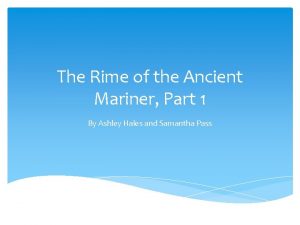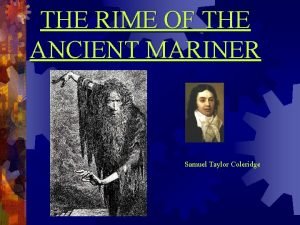The Rime of the Ancient Mariner Guided analysis





- Slides: 5

The Rime of the Ancient Mariner Guided analysis p. 256

1. a. • b. Read lines 1 -40 How is the Mariner described? He has got a “long grey beard”, a “glittering eye” and a “skinny hand”. From the description we get the impression that he is a. – c. • 2. a. • b. • A ghost b a madman c a magician Many details contribute to this impression: his “glittering eye”, the fact that the “Mariner hath his will”. These are typical attributes of a supernatural creature. How does the Wedding-Guest react to the Mariner? The Wedding-guest cannot but stay still and listen to the Mariner’s story, as if he were under a spell. Read lines 41 -62 What happens to the ship? The ship is caught in a storm, then by mist and snow and finally it is surrounded by ice. What natural elements are emphasized? The natural elements emphasized are mist and snow, but especially ice, which is the dominant presence, creating an atmosphere of mystery and tension.

3. a. Read to the end. In line 63 the Albatross is mentioned for the first time. What is it compared to? • It is compared to a Christian soul, as if it were human. b. What is the effect of its presence? • Its presence breaks the ice, so that the ship can start its voyage again. The albatross follow the ship and keeps good company with the crew. c. How does the Mariner react to the bird? • One day the Mariner kills the albatross. d. Is there any reason for his behaviour? • No. The killing of the albatross is one of the most inexplicable events of the poem. 4. Consider the language Highlight in the text more examples of alliteration internal rhyme assonance anaphora

4. Alliteration “long grey beard and glittering eye” (l. 3); “He holds him with his skinny hand” (l. 9); “The Wedding-Guest he beat his breast (l. 37) “in mist or cloud on mast or shroud” (l. 75); Assonance “The ship was cheered the harbour cleared” (l. 21); “growled. . . and. . howled” (l. 61); “ice, mast-high. . by” (l. 53) Internal rhyme “The guest are met, the feast is set” (l. 7); “The ship was cheered the harbour cleared” (l. 21); “Out of the sea came he” (l. 26) ; “And he shone bright and on the right” (l. 27); “in mist or cloud on must or shroud” (l. 75); Anaphora “Below the kirk. . . / Below the lighthouse top” (ll. 23 -24); “And now. . . / And it. . . / And ice. . . (ll. 51 -53); assonance : the similarity in sound between two syllables that are close together, created by the same vowels but different consonants (e. g. 'back' and 'hat'), or by the same consonants and different vowels (e. g. 'hit' and 'heart') anaphora: repetition of a word or expression at the beginning of successive phrases, clauses, sentences, or verses especially for rhetorical or poetic effect

5. a. • b. • c. • Now consider the structure of the poem. The rhyme pattern of the poem is Abcb Each stanza is made up of Four lines and therefore it is a quatrain. This is the traditional structure of a popular genre known as Ballad








